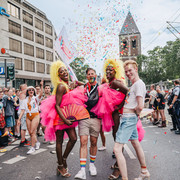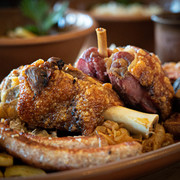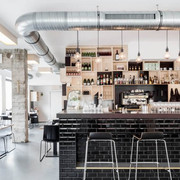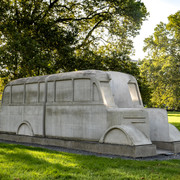Photos & Map
How would you like to arrive?
Details
Useful Information
Nearby
There was a time when cavalry units played a central role on the battlefields of Europe. Even Napoleon increased his cuirassier regiments to a total of 14, with soldiers wearing full cuirass – complete armor with breastplates and backplates, leg and arm guards – as well as a metal helmet with a horsehair plume. Particularly in France, the romanticization of the Napoleonic Wars had such a lasting impact that, until 1914, cuirassiers remained the backbone of the cavalry. However, during the trench warfare of 1914 – 1918, horsehair helmets and spiked helmets were soon replaced by steel helmets and camouflage.
The monument you see at the Deutz Rhine bank, not too far from the Hohenzollern Bridge with its four equestrian statues, stands there in honor of the cuirassier regiment "Graf Gessler" No. 8. The "Graf Gessler" No. 8 regiment was a cavalry unit of the Prussian Army, disbanded in May 1919. The naming comes from the last German Emperor himself, Kaiser Wilhelm II. The regiment was actually stationed here in Cologne for a long time: from 1859 to 1918.
On the other side, you are greeted by another equestrian statue, that of the last German Emperor Wilhelm II. Two more equestrian statues lead you on the other side of the Hohenzollern Bridge: Kaiser Friedrich III and King Friedrich Wilhelm IV. All four strikingly mark the Prussian rule, which is still palpable in many places in Cologne today – as in Fort X with its rose garden.
The monument you see at the Deutz Rhine bank, not too far from the Hohenzollern Bridge with its four equestrian statues, stands there in honor of the cuirassier regiment "Graf Gessler" No. 8. The "Graf Gessler" No. 8 regiment was a cavalry unit of the Prussian Army, disbanded in May 1919. The naming comes from the last German Emperor himself, Kaiser Wilhelm II. The regiment was actually stationed here in Cologne for a long time: from 1859 to 1918.
The Monument Architecture of 1928
The six-meter-high bronze sculpture was designed by the sculptor Paul Wynand, with the lancer being erected between 1928 and 1930 in full armor as a symbol of the military bravery and tradition of this cavalry unit. The monument consists of about 15 individual parts that were screwed, pinned, and riveted together. The pedestal is no longer original but was faithfully reproduced in concrete.In Honor of the Cuirassiers in World War I
Trench warfare, poison gas, artillery, and machine guns – the transition from older forms of warfare to the unimaginable horrors of modern wars rendered the traditional cavalry tactics largely obsolete. An entire era came to an end. The Cuirassier Monument on the Deutz Rhine bank symbolizes the remembrance not only of a specific Cuirassier unit stationed in Cologne, "Graf Gessler" No. 8, but also reminds us of a time when cavalry units were still regarded as symbols of military strength. It additionally marks the transition to modern warfare, serving as a memorial. Beyond this, it also honors and commemorates the fallen soldiers of the Cuirassier Regiment during World War I.Reflection on Another Era
As with Cologne's equestrian statues, a critical examination of such a monument from the Prussian era must not be overlooked. With their majestic poses, they romanticize the horrors that accompany every war and leave the victims and crimes of that time unmentioned. As a sign of its time – marked by militarism, loyalty to the emperor, and glorification of war – the Cuirassier Monument demonstrates, once again, what it is and hopefully remains: a piece of history.Extensively Restored and Refined
Between 2015 and 2018, extensive restoration took place – the damage from World War II had left numerous bullet holes, and the supporting structure made of steel was almost entirely corroded due to water infiltration. The screws were replaced, and a ventilation and drainage system was installed inside. To prevent future weather damage, the monument also received a new skeleton made of flexible stainless steel. The uniform verdigris surface is also a refinement.Further Equestrian Statues: In Honor of Prussian Past
If you walk a bit along the Rhine from the Cuirassier Monument towards the Hohenzollern Bridge, you will soon come across another statue, the monument of the first German Emperor Wilhelm I. From there, you have the opportunity – past the numerous and heavy love locks – to cross Cologne's famous railway bridge on foot.On the other side, you are greeted by another equestrian statue, that of the last German Emperor Wilhelm II. Two more equestrian statues lead you on the other side of the Hohenzollern Bridge: Kaiser Friedrich III and King Friedrich Wilhelm IV. All four strikingly mark the Prussian rule, which is still palpable in many places in Cologne today – as in Fort X with its rose garden.
Useful Information
Eligibility
for Groups
for Class
for families
for individual guests
Suitable for the Elderly
Payment methods
Entrance Free
Nearby











